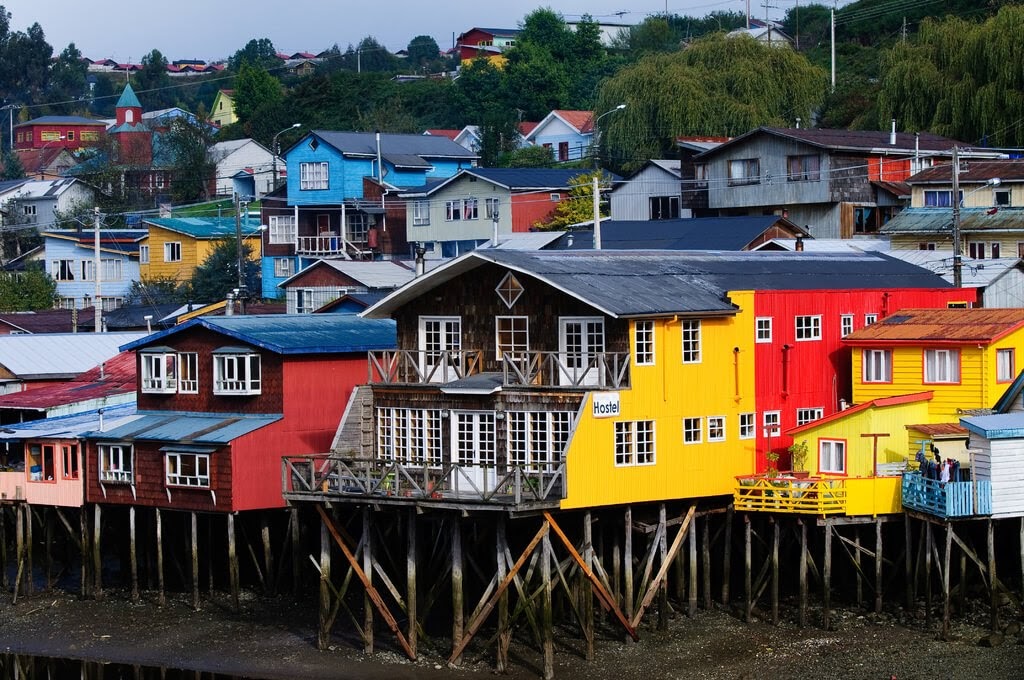My Beloved Chilean Island, Chiloé
The island of Chiloé in South Chile will be marked in my memories forever. When I applied to the English Open Doors program in Chile, I didn’t realize that the program would give me some of the best times of my life.
Run by the government of Chile and the United Nations, English Open Doors invites international volunteers to teach English to government school students in Chile. As a near-native English speaker, I could apply for the volunteer program.
Until I landed in Santiago, I didn’t know that I would be placed in Chiloé. When the program coordinator told me that I had to teach students in Castro, the capital of Chiloé, I ran back to my room and Googled Castro.
Rainbow-like stilt houses lined up against an azure shore. Velvety-green hills filled my screen. Stout lambs grazed over those hillocks in groups. Steam smoked out of a chimney in a hut-shaped roof.
Wooden churches were flaunted in abundance. Legendary and mythical were the keywords on-screen.
Azure rivers, dense national parks, fresh seafood brought a grin to my face.
Related Read: Complete South America Backpacking Guide
Soon, I was on a bus from Santiago to Castro. When the bus reached the closest port to Chiloé, a large ferry awaited us. Instead of getting off the bus, we stayed in, and the bus drove onto the ferry.
While the ferry cruised through the cerulean ocean for the next half an hour, my heartbeat fastened as we sailed closer to Chiloé.
As the bus got off the ferry and drove into the island, all the Google images started materializing.
When I got down at the Castro bus station, my gray-haired Chilean host mother waited with a signboard. We hugged, and she didn’t hesitate for a second before carrying my heavy backpack to the taxi. And thus began my volunteer life in Castro.
A regular day in Castro would begin with dragging myself out of the seven blankets in that cold month of August. I avoided looking outside from the small window of my second-floor room as the town would still be dark at 7 in the morning.
Sometimes I was sleepier than the rest of the days for the rain had smashed against the brick-tiled roof all-night keeping me awake. But a rushed Nescafe coffee jerked me enough that I could hop onto a taxi and head to the school.
After teaching for a few hours, I walked home for lunch.
My host mother always waited with a hot lunch. A bowl of chicken or algae Casuella, the typical soup of Chiloé, a salad, jelly for dessert, and toast or rice was the usual meal.
The rich food was complimented by an even richer culture of Chiloé. I could take a bus to any village on the island. In Chiloé, you pay the bus drivers when you leave, and those Caballeros are always smiling.
The lamb-studded velvety hills were real, and many Chilean friends invited me to their wooden cottages perched atop those hills.
Apple and cherry trees filled the gardens. Homemade alcohol a.k.a aguardientes was stronger than Long Island Ice Tea. Roadside stalls sold handmade woolen scarfs and socks.
The grocery shop owner near my house became a friend and worried if I didn’t show up every few days.
I gifted the Gato wine to many families who invited me to their homes. Celebrations were spent huddled around the barbecue with wine or terremotos in hand.
When I felt like venturing out, I went to the centuries-old wooden churches, hiked in national parks, or watched the sunset over the ocean.
Understanding local customs took time.
Mingas, or joint activities, could even shift a whole house. Curanto, steamed clams, was made on a special day.
While parties ran until morning, the days were relaxed. Families ate together in a small kitchen warmed by a wood-fired oven-cum-stove.
Dinner was replaced by once eaten at 6-7 pm. Cheese, jam, toast, eggs, leftovers filled our dining table along with broken Spanish conversations.
Those Spanish conversations seeped into my dreams, too.
My host mother called me hija, her daughter, and she was my mamá. Together we would buy groceries and fresh fish from the port, and the cooking would begin.
Indian or Chilean, the flavors were full of love. Now back at home I search for sea algae to add to soups, while mamá eats garbanzos aka chickpeas made in Indian style.
Chiloé would be my favorite place until another destination makes me feel at home. A place where locals again become family. Where a host mother tells bedtime stories with free cuddles. Where a new day brings unseen adventures. Where lunch calls for an aperitivo. Where hills would be greener and soups richer.
Until then Chiloé would be my favorite place.
Do you miss someplace as badly as I miss Chiloé, too?
Read Next: My guide to traveling Chile – Secrets from a 6-month trip
*****
*****
Want similar inspiration and ideas in your inbox? Subscribe to my free weekly newsletter "Looking Inwards"!

